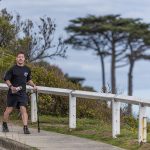“IT’S BEEN A NON-SWALLOWING DAY, EVEN THOUGH THEY ARE ALL WINE LOVERS”.
At first glance, the 20-odd people sitting around the table at Crittenden Wines appear to be indulging in a rather heavy after-lunch drinking session. But stay and watch a little longer and you’ll notice no one is swallowing their wine.
Although nine glasses containing red wine sit in front of each person, a little red plastic cup gives the story away. The men and women around the table are here to taste the wine.
It’s been a non-swallowing day, even though they are all wine lovers.
Crittenden’s in Harrisons Rd, Dromana is the final stop for 10 sommeliers touring Mornington Peninsula wineries as a side trip to their attendance at The World’s 50 Best Restaurants 2017 awards in Melbourne. New York’s Eleven Madison Park took out the top spot.
The tour of the peninsula started at Stonier Winery, Merricks, where the group was welcomed by Mornington Peninsula Vignerons Association CEO Cheryl Lee.
From there the sommeliers from the United Kingdom, United States, Japan, New Zealand and interstate went to Ocean Eight, Shoreham and then to the top of Arthurs Seat before having lunch at Petit Tracteur, Main Ridge.
The final stop for the day was at Crittendens, where they tasted nine wines and were told about production methods and differences between vineyards where they were made by winemakers including Rollo Crittenden (Crittendens Wines), Martin Spedding (Ten Minutes by Tractor), Kathleen Quealy (Balnarring Vineyard) and Glen Hayley (Port Phillip Estate).
Sommeliers Australia describes a sommelier as being “a specialist wine waiter/wine steward who is a trained and knowledgeable wine professional who specialises in all facets of beverage service”.
It ranks sommeliers as being “strategically on a par with that of the executive chef or chef de cuisine”.
Sommeliers are responsible for buying and storing wine, developing wine lists and training other restaurant staff about wine.
The tours of peninsula wineries was organised by Wine Australia, which wants “Australia [to be] recognised as the world’s pre-eminent wine producer”.
Once at Crittendens the sommeliers sit at tables arranged in a rectangle and the winemakers speak about their products, their vineyards and the attributes of the peninsula – its soils and climate – for nurturing the pinot noir variety of grape.
This is serious stuff and the sommeliers make notes – on paper and computer – and ask questions. The questioning always comes round to the price of a bottle and with the quality of wine under discussion the answer usually comes in between $50 and $65.
Rollo Crittenden begins the discussion by describing the peninsula’s “three to five degrees cooler than Melbourne’s” climate as “maritime rather than Mediterranean” due to the effects of Western Port and Port Phillip bays and Bass Strait.
The peninsula “tends not to have frosts”, although a range of soils means “individual sites are quite different”.
Martin Spedding, of Ten Minutes by Tractor, Main Ridge, described how planning a new vineyard was “a great opportunity to plant from scratch”.
“We’ll be able to question everything we do and why, from the vineyard’s architecture to using machinery. We’re starting with what we think is best for the fruit.”
Spedding said the vines would be spaced to enable use of a 68 centimetre wide tractor.
“There will be smaller wines with fewer bunches [of fruit] – time will tell if we are right or not.”
Kathleen Quealy, of Balnarring Vineyard, Balnarring, said her vines were pruned so they get as much sunshine as possible “which makes a very rich, satisfying wine”.
She said she would be “going for organic certification in the next 12 months”.
Glen Hayley, Port Phillip Estate, said the “very exposed” position and the “sand a silt dominant soil” of the company’s vineyard “adds resilience and interest to the fruit”.
The UK was the estate’s biggest overseas market for its “darker richer styles of wine”.





